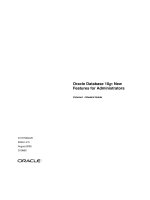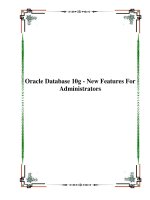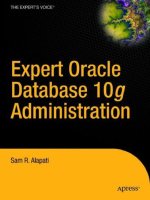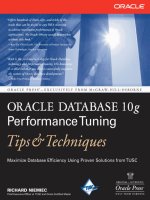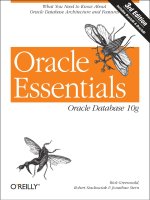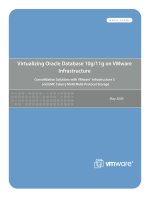Oracle Database 10g Real (RAC10g R2) on HP-UX Installation Cookbook phần 1 pdf
Bạn đang xem bản rút gọn của tài liệu. Xem và tải ngay bản đầy đủ của tài liệu tại đây (140.96 KB, 10 trang )
Oracle Database 10g Real Application Clusters R2
(RAC10g R2) on HP-UX Installation Cookbook
This document is based on our experiences, it is not an official HP/Oracle documentation. We're constantly
updating this installation cookbook, therefore please check for the latest version of this cookbook on our
HP/Oracle CTC web page at (pdf version).
If you have any comments or suggestions, please send us an email with your feedback! In case of issues
during your installation, please also report this problem to HP and/or Oracle support.
Contents:
1. Aim of this document
Authors: Rebecca Schlecht (HP), Rainer Marekwia (Oracle)
EMEA HP/Oracle Cooperative Technology Center (CTC)
Date: 26th January 2007
1. Aim of this document
2. Key New Features for RAC10g on HP-UX
3. Supported Configurations with RAC10g on HP-UX
4. General System Installation Requirements
4.1 Hardware Requirements
4.2 Network Requirements
4.3 Required HP-UX Patches
4.4 Kernel Parameter Settings
5. Create the Oracle User
6. Oracle RAC 10g Cluster Preparation Steps
6.1 RAC 10g with HP Serviceguard Cluster File
System for RAC
6.2 RAC 10g with RAW over SLVM
6.3 RAC 10g with ASM over SLVM
6.4 RAC 10g with ASM
7. Preparation for Oracle Software Installation
7.1 Prepare HP-UX Systems for Oracle software
installation
7.2 Check Cluster Configuration with Cluster
Verification Utility
8. Install Oracle Clusterware
9. Installation of Oracle Database RAC10g R2
10. Configure the Oracle Listeners
11.
Create a RAC DB on CFS using Database
Configuration Assistant
12. Oracle Enterprise Manager 10g Database Control
13.
Implementation of SG Packages Framework for RAC
10g
14. Tips & Tricks
15. Known Issues & Bug Fixes
Page
1
of
51
HP/Oracle CTC RAC10g R2 on HP
-
UX cookbook
This document is intended to provide help installing Oracle Real Application Clusters 10g Release
2 on HP servers running HP-UX operating system. This paper covers both Integrity and PA-RISC
platform.
All information here is based on practical experiences.
All described scenarios are based on a 2 node cluster, node1 referred to as 'ksc' and node2 as
'schalke'.
In this paper, we use the following logic:
ksc# <command>
= command needs to be issued as root from node ksc
schalke$ <command>
= command needs to be issued as oracle from node schalke
ksc/schalke# <command> = command needs to be issued as root from both nodes ksc + schalke
and so on.
This document should be used in conjunction with the following Oracle documentation:
It also includes material from HP Serviceguard + RAC10g papers written by ACSL labs which are
available HP internally at />
2. Key New Features for RAC10g on HP-UX
Oracle Clusterware
New with RAC 10g, Oracle includes its own Clusterware and package management
solution with the database product. The Oracle Clusterware consists of
l
Oracle Cluster Synchronization Services (CSS) to provide cluster management
functionality
l
Oracle Cluster Ready Services (CRS) support services and workload
management and help to maintain the continuous availability of the services.
CRS also manages resources such as the virtual IP (VIP) address for the node
and the global services daemon.
l
Event Management (EVM) publishes events generated by CRS
B25292-02 Oracle® Database Release Notes 10g Release 2 (10.2) for HP-UX Itanium (pdf html)
B19067-04 Oracle® Database Release Notes 10g Release 2 (10.2) for HP-UX PA-RISC (64-Bit) (pdf html)
B14202-04 Oracle Clusterware and Oracle Real Application Clusters Installation and Configuration Guide for hp HP-
UX (
Page
2
of
51
HP/Oracle CTC RAC10g R2 on HP
-
UX cookbook
This Oracle Clusterware is available on all various Oracle RAC platforms and based on
the HP TruCluster product which Oracle licensed a couple of years ago.
Customers can now deploy Oracle RAC clusters without any additional 3rd party
clusterware products such as SG/SGeRAC. However, customers might want to
continue to use SG/SGeRAC for the cluster management (e.g. to make your complete
cluster high available including 3rd party application, interconnect, etc.). In this case
Oracle Clusterware interacts with the SG/SGeRAC to coordinate cluster membership
information.
New Features for Oracle Clusterware with RAC 10g R2:
l
Oracle 10g R2 comes with new Cluster Verification Utility that you can use to
check whether or not your cluster is properly configured, to avoid installation
failures, and to avoid database creation failures.
l
With 10g R2, Oracle Clusterware provides the possibility to mirror the Oracle
Cluster Registry (OCR) file, enhancing cluster reliability.
l
With 10g R2, CSS has been modified to allow you to configure multiple voting
disks. In RAC10g R1, you could configure only one voting disk. By enabling
multiple voting disk configuration, the redundant voting disks allow you to
configure a RAC database with multiple voting disks on independent shared
physical disks.
l
With Oracle 10g R2, in addition, while continuing to be required for RAC
databases, Oracle Clusterware is also available for use with single-instance
databases and applications that you deploy on clusters. The API libraries
required for use with single-instance databases are provided with the Oracle
Client installation media.
Oracle Automatic Storage Management
Oracle Automatic Storage Management (ASM) is a new feature that has be introduced
in Oracle Database 10g to simplify the storage of Oracle data. ASM virtualizes the
database storage into disk groups. The DBA is able to manage a small set of disk
groups and ASM automates the placement of the database files within those disk
groups.
In summary ASM does provide the following functionality:
l
Manages groups of disks, called disk groups.
l
Provides three mirroring options for protection against disk failure: none, two-
way, and three-way mirroring.
l
Spreads data evenly across all available storage resources to optimize
performance and utilization.
l
Enables the DBA to change the storage configuration without having to take the
database offline.
l Automatically rebalances files across the disk group after disks have been added
or dropped.
New Features for Oracle ASM with 10g R2:
l
ASM Command-Line Utility for ASM file administration:
$ asmcmd help
l
Oracle 10g R2 supports installation of Automatic Storage Management in a
separate ASM home directory.
l
Supports interoperability for all versions of ASM and Database instances starting
Page
3
of
51
HP/Oracle CTC RAC10g R2 on HP
-
UX cookbook
with RAC10g R1. This allows the ASM instance and DB instance to be upgraded
independently:
l
ASM migration utility with Enterprise Manager Grid Control GUI
HP Serviceguard Cluster File System for Oracle RAC
In September 2005, HP announced the availability of the new HP Serviceguard
Storage Management Suite that offers enhanced database, cluster, and performance
management capabilities for HP-UX 11i environments by integrating HP Serviceguard
and Symantec VERITAS Storage Foundation. This new product suite is ideally suited
to customers who need the highest levels of availability and superior Oracle database
performance or who have an application that would benefit from a clustered file
system.
The HP Serviceguard Cluster File System for Oracle RAC Suite includes the following
technologies from Symantec VERITAS Storage Foundation:
l
Cluster File System (CFS)—provides excellent I/O performance and simplifies
the installation and ongoing management of a RAC database
l
Advanced volume management and file system (AVMFS) capabilities—offers
dynamic multipathing, database tablespace growth, and hot relocation of failed
redundant storage. It also provides a variety of online options, including storage
reconfiguration and volume and file system creation and resizing.
l
Oracle Disk Manager (ODM)—delivers almost raw performance running direct
I/O by caching frequently accessed data
l
Quality of storage service (QoSS)—enables administrators to set policies that
segment company data based on various characteristics and assign the data to
appropriate classes of storage over time
l
FlashSnap—helps database administrators easily establish a database clone, a
duplicate database on a secondary host for off-host processing
This HP Serviceguard Storage Management Suite is offered and supported directly
from HP for a single point of contact for all your support needs.
HP Product Number: T2777BA (HP Serviceguard CFS for RAC LTU).
3. Supported Configurations with RAC10g on HP-UX
Customers do have a variety of choices with regards to the installation and set-up of Oracle Real
Application Clusters 10g on the HP-UX platform.
First customers need to make a decision with regards to the underlying cluster software.
Customers have the possibility to deploy their RAC cluster only with Oracle Clusterware.
Alternatively, customers might want to continue to use HP Serviceguard & HP Serviceguard
Extension for RAC (SGeRAC) for the cluster management. In this case Oracle’s CSS interacts
with HP SG/SGeRAC to coordinate cluster membership information.
Page
4
of
51
HP/Oracle CTC RAC10g R2 on HP
-
UX cookbook
For storage management, customers have the choice to use Oracle ASM, HP's Cluster File
Systems or RAW Devices.
Please note, for RAC with Standard Edition installations, Oracle mandates that the Oracle data
must be placed under ASM control.
The figure below illustrates the supported configurations with Oracle RAC10gR2 on HP-UX.
The following table shows the storage options supported for storing Oracle Clusterware files,
Oracle database files, and Oracle database recovery files. Oracle database files include data files,
control files, redo log files, the server parameter file, and the password file. Oracle Clusterware
files include Oracle Cluster Registry (OCR) and Voting disk. Oracle Recovery files include archive
log files.
4. General System Installation Requirements
4.1 Hardware Requirements
l at least 1GB of physical RAM. Use the following command to verify the amount of memory
installed on your system:
# /usr/contrib/bin/machinfo | grep -i Memory
or
# /usr/sbin/dmesg | grep
"Physical:"
l
Swap space equivalent to the multiple of the available RAM, as indicated here:
¡
If RAM between 1GB and 2GB, then swap space required is 1.5 times the size of RAM
¡
If RAM > 2GB, then swap space required is equal to the size of RAM
RAC 10g R2
SG/SGeRAC & Oracle
Clusterware
Oracle Clusterware Only
SLVM
CVM
RAW ASM RAW CFS
ASM
Storage Option Clusterware Database Recovery
Automatic Storage
Management
No Yes Yes
Shared raw logical volumes
(requires SGeRAC)
Yes Yes No
Shared raw disk devices as
presented to hosts
Yes Yes No
Shared raw partitions (only HP
Integrity, no PA-Risc)
Yes Yes No
CFS Yes Yes Yes
Page
5
of
51
HP/Oracle CTC RAC10g R2 on HP
-
UX cookbook
Use the following command to determine the amount of swap space installed on your
system:
# /usr/sbin/swapinfo -a
l
400 MB of disk space in the /tmp directory. To determine the amount of disk space available
in the /tmp directory, enter the following command:
# bdf /tmp
If there is less than 400 MB of disk space available in the /tmp directory extend the file
system or set the TEMP and TMPDIR environment variables when setting the oracle user's
environment. This environment variables can be used to override /tmp.:
$ export TEMP=/directory
$ export TMPDIR=/directory
l
4 GB of disk space for the Oracle software. You can determine the amount of free disk
space on the system using
# bdf -k
l
1.2 GB of disk space for a preconfigured database that uses file system storage (optional)
l
Operating System: HP-UX 11.23 (Itanium2), 11.23 (PA-RISC), 11.11 (PA-RISC). To
determine if you have a 64-bit configuration enter the following command:
# /bin/getconf KERNEL_BITS
To determine which version of HP-UX is installed, enter the following command:
# uname -a
l
Asnyc I/O is required for Oracle on RAW devices and configured on HP-
UX 11.23 by default.
You can check if you have the following file:
# ll /dev/async
# crw-rw-rw- 1 bin bin 101 0x000000 Jun 9 09:38 /dev/async
l
If you want to use Oracle on RAW devices and Async I/O is not configured, then
¡
Create the /dev/async character device
# /sbin/mknod /dev/async c 101 0x0
# chown oracle:dba /dev/async
# chmod 660 /dev/async
¡
Configure the async driver in the kernel using SAM
=> Kernel Configuration
=> Kernel
=> the driver is called 'asyncdsk'
Generate new kernel
Reboot
¡ Set HP-UX kernel parameter
max_async_ports
using SAM.
max_async_ports
limits the
maximum number of processes that can concurrently use
/dev/async
. Set this
parameter to the sum of 'processes' from init.ora + number of background processes. If
max_async_ports
is reached, subsequent processes will use synchronous i/o.
¡
Set HP-UX kernel parameter
aio_max_ops
using SAM.
aio_max_ops
limits the maximum
number of asynchronous i/o operations that can be queued at any time. Set this
parameter to the default value (2048), and monitor over time using glance
l
For PL/SQL native compilation, Pro*C/C++, Oracle Call Interface, Oracle C++ Call Interface,
Oracle XML Developer’s Kit (XDK):
¡
HP-UX 11i v2 (11.23):
n
HP C/ANSI C Compiler (A.06.00): C-ANSI-C
n HP aC++ Compiler (C.06.00): ACXX
To determine the version, enter the following command:
# cc -V
Page
6
of
51
HP/Oracle CTC RAC10g R2 on HP
-
UX cookbook
l
To allow you to successfully relink Oracle products after installing this software, please
ensure that the following symbolic links have been created (HP Doc-Id KBRC00003627):
# cd /usr/lib
# ln -s /usr/lib/libX11.3 libX11.sl
# ln -s /usr/lib/libXIE.2 libXIE.sl
# ln -s /usr/lib/libXext.3 libXext.sl
# ln -s /usr/lib/libXhp11.3 libXhp11.sl
# ln -s /usr/lib/libXi.3 libXi.sl
# ln -s /usr/lib/libXm.4 libXm.sl
# ln -s /usr/lib/libXp.2 libXp.sl
# ln -s /usr/lib/libXt.3 libXt.sl
# ln -s /usr/lib/libXtst.2 libXtst.sl
l
Ensure that each member node of the cluster is set (as closely as possible) to the same date
and time. Oracle strongly recommends using the Network Time Protocol feature of most
operating systems for this purpose, with all nodes using the same reference Network Time
Protocol server.
4.2 Network Requirements
You need the following IP addresses per node to build a RAC10g cluster:
l
Public interface that will be used for client communication
l
Virtual IP address (VIP) that will be bind by Oracle Clusterware to the public interface
(Why having this VIP? Well, clients will use this VIP addresses/names to access the RAC
database. If a node or interconnect fails, then the affected VIP is relocated to the surviving
instance, enabling fast notification of the failure to the clients connecting through that VIP ->
prevents TCP/IP timeout!)
l
Private interface that will be used for inter-cluster traffic. There are four major categories of
inter-cluster traffic:
¡
SG-HB= Serviceguard heartbeat and communications traffic. This is supported over
single or multiple subnet networks.
¡
CSS-HB = Oracle CSS heartbeat traffic and communications traffic for Oracle
Clusterware. CSS-HB uses a single logical connection over a single subnet network.
¡
RAC-IC = RAC instance peer to peer traffic and communications for Global Cache
Service (GCS) and Global Enqueue Service (GES), formally Cache Fusion (CF) and
Distributed Lock Manager (DLM).
¡
GAB/LLT (only when using CFS/CVM) = Symantec cluster heartbeat and
communications traffic. GAB/LLT communicates
over link level protocol (DLPI) and is supported over Serviceguard heartbeat subnet
networks, including primary and standby links. GAB/LLT is not supported over APA or
virtual LANs (VLAN).
When configuring these networks, please consider:
l
The public and private interface names associated with the network adapters for each
network should be the same on all nodes, e.g. lan0 for private interconnect and lan1 for
public interconnect. If this is not the case, you can use the ioinit command to map the LAN
interfaces to new device instances:
¡
Write down the hardware path that you want to use:
# lanscan
Hardware Station Crd Hdw Net-Interface NM MAC HP-DLPI DLPI
Path Address In# State NamePPA ID Type Support Mjr#
1/0/8/1/0/6/0 0x000F203C346C 1 UP lan1 snap1 1 ETHER Yes 119
1/0/10/1/0 0x00306EF48297 2 UP lan2 snap2 2 ETHER Yes 119C
Page
7
of
51
HP/Oracle CTC RAC10g R2 on HP
-
UX cookbook
¡
Create a new ascii file with the following syntax:
Hardware_Path Device_Group New_Device_Instance_Number
Example:
# vi newio
1/0/8/1/0/6/0 lan 8
1/0/10/1/0 lan 9
Please note that you have to choose a device instance number that is currently not in
use.
¡
Activate this configuration with the following command (-r option will issue a reboot):
# ioinit -f /root/newio -r
¡
When the system is up again, check new configuration:
# lanscan
Hardware Station Crd Hdw Net-Interface NM MAC HP-DLPI DLPI
Path Address In# State NamePPA ID Type Support Mjr#
1/0/8/1/0/6/0 0x000F203C346C 1 UP lan8 snap8 1 ETHER Yes 119
1/0/10/1/0 0x00306EF48297 2 UP lan9 snap9 2 ETHER Yes 119
l
For the public network,
¡
each network adapter must support TCP/IP.
l
For the private network,
¡
this must be configured in the /etc/hosts file on each node to associate private network
names with private IP addresses.
¡
the interconnect must support UDP as this is the default interconnect protocol for
cache fusion, and TCP is the interconnect protocol for Oracle Clusterware.
¡
Gigabit Ethernet or better is recommended, Hyperfabric is not supported any longer!
¡
Crossover cables are not supported for the cluster interconnect; switch is mandatory
for production implementation, even for only 2 nodes architecture.
¡
It is preferred to have all interconnect traffics (SG-HB, CSS-HB, RAC-IC, opt.
GAB/LLT) for cluster communications to go on a single heartbeat network that is
redundant so that Serviceguard will monitor the network and resolve interconnect
failures by cluster reconfiguration:
As illustrated in this picture, the primary and standby pair protects against single
failure. Serviceguard monitors the network and performs local LAN failover if the
primary fails. The local LAN failover is transparent to CSS-HB and RAC-IC. When both
primary and standby fails, Serviceguard resolves the interconnect failure by performing
a cluster reconfiguration. After Serviceguard completes its reconfiguration, SGeRAC
notifies CSS and CSS updates RAC.
¡
Please note that CSS-HB timeout default is 30sec for clusters without Serviceguard
and 600 for clusters with Serviceguard. This ensures that Serviceguard will be first to
recognize any failures and to initiate cluster reformation activities. (See Oracle Metalink
Page
8
of
51
HP/Oracle CTC RAC10g R2 on HP
-
UX cookbook
Note 294430.1 "CSS Timeout Computation in RAC 10g (10g Release 1 and 10g
Release 2)")
¡
However, in some cases it might not be possible to place all interconnect traffic on the
same network. For example if RAC-IC traffic is very high, so that a separate network
for RAC-IC may be needed.
As illustrated in this picture, each primary and standby pair protects against single
failure. The SG-HB and CSS-HB are placed on the same private network so that all
heartbeat traffic remains on the same network. SG-HB is used to resolve interconnect
failure where both primary and standby failed of the heartbeat network. Where there is
a concern when both lan1 and lan2 failed, Serviceguard supports multiple standby
adapters to increase availability. Additionally, Serviceguard packages can be
configured with a subnet dependency on the RAC-IC network so that if both lan1 and
lan2 failed, the Serviceguard package can request halting the RAC instance on the
node where the interconnect failure is detected.
¡
For cluster without HP Serviceguard, you can use HP Auto Port Aggregation (APA) to
increase reliability for public and private network adapters.
l
For the virtual IP (VIP) address,
¡
this must be on the same subnet as the public interface
¡
this must be registered in DNS or maintained in /etc/hosts with the associated network
name.
¡
this Oracle VIP feature works at a low level with the device files for the network
interface cards, and as a result might clash with any other SG Relocatable IP
addresses also configured for the same public NIC. Therefore, it has not been
supported to configure the public NIC used for Oracle VIP also for any other SG
Relocatable IP address.
n
This issue has been addressed with Oracle bug fix #4699597 which ensures that
Oracle VIP starts with logical interface number 801 (ie. lan1:801) so that there
will not be any conflict with SG's Relocatable IP's.
n
This Oracle bug fix #4699597 is already available for 10.2.0.2 HP-UX Integrity
and will be available for PA-RISC with 10.2.0.3.
¡
See Oracle Metalink Note 296874.1 "Configuring the HP-UX Operating System for the
Oracle 10g VIP")
Page
9
of
51
HP/Oracle CTC RAC10g R2 on HP
-
UX cookbook
Useful network commands:
# lanscan # Determines the number of LAN interfaces on each node
# netstat -in # Displays information for all network interfaces such
as IP address, state, etc.
# ifconfig lanX # Displays current configuration for a specific
interface
(Config File: /etc/rc.config.d/netconf)
4.3 Required HP-UX Patches
HP-UX 11.23 (Integrity & PA-RISC):
l
HP-UX B.11.23.0409 or later
l
Patch Bundle for HP-UX 11i V2: BUNDLE11i_B.11.23.0409.3 (Note: patch bundle
BUNDLE11i_B.11.23.0408.1 (Aug/2004) is a prerequisite for installing
BUNDLE11i_B.11.23.0409.3)
l
Quality Pack Bundle:
¡
Latest patch bundle: Quality Pack Patches for HP-UX 11i v2, May 2005
l
HP-UX 11.23 Patches:
¡
PHCO_32426 Reboot(1M) cumulative patch
¡ PHCO_34208 11.23 cumulative SAM patch [replaces PHCO_31820]
¡
PHCO_34195 11.23 kernel configuration commands patch [replaces PHCO_33385]
¡
PHCO_35048 11.23 libsec cumulative patch
¡ PHKL_32646 wsio.h header file patch
¡
PHKL_33025 11.23 file system tunables cumulative patch
¡ PHKL_34907 Message Signaled Interrupts (MSI and MSI-X) [replaces
PHKL_32632,PHKL_33807,PHKL_34430]
¡
PHKL_34479 WSIO (IO) subsystem MSI/MSI-X/WC Patch [replaces PHKL_32645]
¡ PHKL_35229 VM Copy on write data corruption fix [replaces
PHKL_33552,PHKL_33563,PHKL_34596]
¡ PHNE_35182 11.23 cumulative ARPA Transport patch
¡ PHSS_34859 11.23 Integrity Unwind Library [replaces PHSS_31851,PHSS_34043]
¡
PHSS_34858 11.23 linker + fdp cumulative patch [replaces
PHSS_34040,PHSS_33275,PHSS_31849,PHSS_34440]
¡
PHSS_34444 11.23 assembler patch [replaces PHSS_31850,PHSS_34044]
¡ PHSS_34445 11.23 milli cumulative patch [replaces PHSS_31854,PHSS_34045]
¡ PHSS_34853 11.23 Math Library Cumulative Patch [replaces PHSS_33276,PHSS_34042]
¡
PHNE_35182 11.23 cumulative ARPA Transport patch [replaces PHNE_34671]
l
ANSI + C++ patches:
¡
PHSS_32511 11.23 HP aC++ Compiler (A.03.63)
¡ PHSS_32512 11.23 ANSI C compiler B.11.11.12 cumulative patch
¡ PHSS_32513 11.23 +O4/PBO Compiler B.11.11.12 cumulative patch
¡
PHSS_35055 11.23 aC++ Runtime [replaces PHSS_31855,PHSS_34041,PHSS_31852]
l
JDK patches:
¡
PHCO_34944 11.23 pthread library cumulative patch [replaces
PHCO_31553,PHCO_33675,PHCO_34718]
¡ PHSS_35045 11.23 Aries cumulative patch [replaces PHSS_32213,PHSS_34201]
¡
PHKL_31500 11.23 Sept04 base patch
¡ check for additional patches that may be
required by JDK.
Page
10
of
51
HP/Oracle CTC RAC10g R2 on HP
-
UX cookbook




